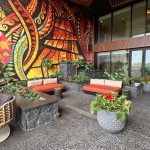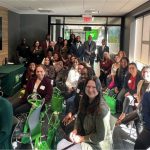In today's rapidly evolving business landscape, one concept stands out as a crucial driver of success: cultural equity. As businesses strive to adapt to a changing world and embrace diversity in all its forms, understanding and prioritizing cultural equity has become...
Opening The Doors To Medical School For People Of Color
By Lucelis Martinez
As a child of Somali refugees, Abdikarin Abdullahi saw firsthand how quickly personal health can become an afterthought in communities of color. He grew up in a family with limited financial means. When they got sick, he and his siblings learned from grownups that they should “let time be the care,” and not seek intervention from medical providers. Abdullahi dreamed of “tackling” the health care system to increase access to care in marginalized communities. He says health care workers from underrepresented communities often give back to the places where they grew up, and he wants to help students who have that intent, too.
Abdullahi graduated from the UCSF School of Medicine in May, and now he is known to his patients as Dr. Abdi. He learned from his academic experiences earning an MD and an MPH that seeking admission to medical school is a long and expensive process that discourages hundreds of students from applying and causes them to give up on dreams of practicing medicine. Abdullahi created Bridging Admissions, a free student-led mentorship program that helps underrepresented racial and ethnic groups and first-generation college students in applying to medical school. Bridging Admissions also operates the Hope Fellowship Program, which awards selected students a $2,500 stipend to cover expenses related to applying to medical school.
Each year, the program mentors hundreds of students across California. Research shows that mentorship and advising provide important support for prospective medical school applicants and are key to diversifying medical school enrollment, which is disproportionately White, Asian, and affluent. Currently, 6% of California physicians are Latino/x, 3% are Black, and less than 1% are American Indian and Alaska Native — all well below each group’s share of the general population.
I spoke with Abdullahi about his inspiring personal journey and his work with Bridging Admissions. This transcript has been lightly edited for length and clarity.
Q: How did you decide to start Bridging Admissions?
A: I started it back in 2018 after finishing my own medical school application process. I had no one in my family with a career in medicine, and I found it stressful to navigate everything on my own. It costs thousands of dollars to fill out applications, fly out to interviews, and get accommodations.
Because I was financially strapped, I would try to book flights to either get in and get out that same day or to leave early the next day after spending the night at the airport. I didn’t want the system to fail other students the way that it had failed me. One big thing that makes a difference for applicants is connecting with med students or people who have recently been through that process, because it’s always changing so much. It makes me feel very old, but the process has changed two, three, four times since I applied six years ago. I think that being plugged into people who have gone through it recently makes a big difference.
Q: How many students have you been able to help so far?
A: Our program has been very successful thus far. Annually, we typically help roughly 280 to 400 students who apply to our free mentorship program. The program provides things like one-to-one mentorship between applicants and current medical students, webinars on writing personal statements, and preparation for med school interviews.
We also have the Hope Fellowship Program which provides the stipends to selected applicants. In the fellowship’s first year, we took 15 students, and 14 of them were able to secure at least one acceptance to med school. Many have gotten into the top medical schools in the country, and so we’re very proud of that cohort. This year, 9 of the 10 students who were accepted into our cohort were ultimately accepted to one or more med schools. These students are all incredible people who have overcome tremendous adversity, and we are very proud of them.
Q: What makes Bridging Admissions so successful?
A: We’re run by the very students who are underrepresented in medicine: students who are first generation, students who grew up with low incomes, and those who were feeling excluded from a career in medicine. Our momentum is propelled by the fact that we can relate to the experiences of those we’re helping. We want to show them how we were able to achieve success, so they can too. It’s been one of the key parts of our organization and something that we want to stay true to. Some of the scholarship applications we receive talk about dealing with homelessness or not being able to afford meals. Deciding to apply to medical school is incredibly challenging, especially when you feel like you don’t have anyone in your corner. We’ve been proud to be there for these applicants.
Q: How have you funded your organization?
A: Just as our organization has been grassroots in the way we mentor and operate, it’s the same in the way we secure grant funds. We send out many unsolicited emails to different organizations talking about who we are. We put together a slide deck, and we pitch that this is important work. We tell prospective donors, “We know that you care about diversity, equity, and inclusion. We know that you are an organization that would be invested in diversifying in the physician workforce.”
Q: Why should people care about diversifying the health care system?
A: It not only matters from a health equity perspective, it also matters from a justice perspective. Everyone should have a fair opportunity and an equal chance to pursue a career in medicine. It’s also important because these providers of color coming from communities that are currently unable to access a career in medicine will make our communities healthier — and that benefits everybody. If we invest in improving the health of people of color, it’s going to improve the health of our society and our state overall.
Early in the COVID-19 pandemic, for example, morbidity and mortality rates were especially terrible in communities of color. There were many conversations about how to best reach people, but folks from within the communities had a unique stake in figuring it out. They said, “Hey, let’s show up in the barbershops,” “Let’s do this,” “Let’s do that.” And those folks that are part of those communities can connect to them a bit easier. When it comes to tackling health inequities, that makes a really big difference.
Q: How would Bridging Admissions benefit from additional funding?
A: After we ultimately select the 10 to 15 students who will receive funding through the Hope Fellowship each year, we receive a flood of emails from students who were not funded. They say, “Hey, I’m not sure if I can apply anymore because I didn’t get the scholarship. I know there are many qualified candidates, and your decision’s hard, but how else can you help me?” This is one of the hardest things about what our organization does. There are students who we unfortunately just can’t help or support because our funding is limited. And so that’s always challenging because there are so many excellent candidates, so many students who are navigating tremendous obstacles and adversity. It’d be fantastic if we could support more students with med-school application stipends.
Q: When you were a kid, did you picture yourself becoming a doctor?
A: Because there are so many barriers in place, folks like me don’t envision a career in medicine as a possibility. My father was a taxi driver, and my mom didn’t work, so 10-year-old me was not thinking about being a doctor. Early investment in education in underrepresented communities, strengthening academic and recruitment pipelines from community college, and investing in programs like ours are all ways to overcome barriers like the ones I faced.
Q: What do you dream of now?
A: As a medical student, I saw patients who were like, “Hey, I’ve never had a Black doctor.” I’d tell them, “I’m not there yet.” And they’d say, “It’s fine. I’m going to call you ‘doctor’ anyway. When you’re done, let me know. I want you to be my doctor.” That was incredibly touching on a personal level, and it was also sad. How is someone who’s 40 or 50 years old saying they haven’t had a Black provider before? From the ways in which we were able to connect, it was clear to me that it made them more comfortable, and it was a great experience for both of us. I want more providers and patients to have that experience.
Did your presence in medical school have an impact on other students?
A: I think everyone from underrepresented communities brings important perspectives and insights that help future patients and the providers who we train with. Sitting in small group sessions and being able to talk with my peers, it’s very clear when the folks from more affluent backgrounds — the people who have, say, two physicians as parents — are not aware of the struggles that peers from other communities face. Being able to say, “Hey, actually this is my perspective,” enriches the educational experience of all medical students. I think these interactions will have downstream impacts on their patients.
See Original Article at California Health Care Foundation









